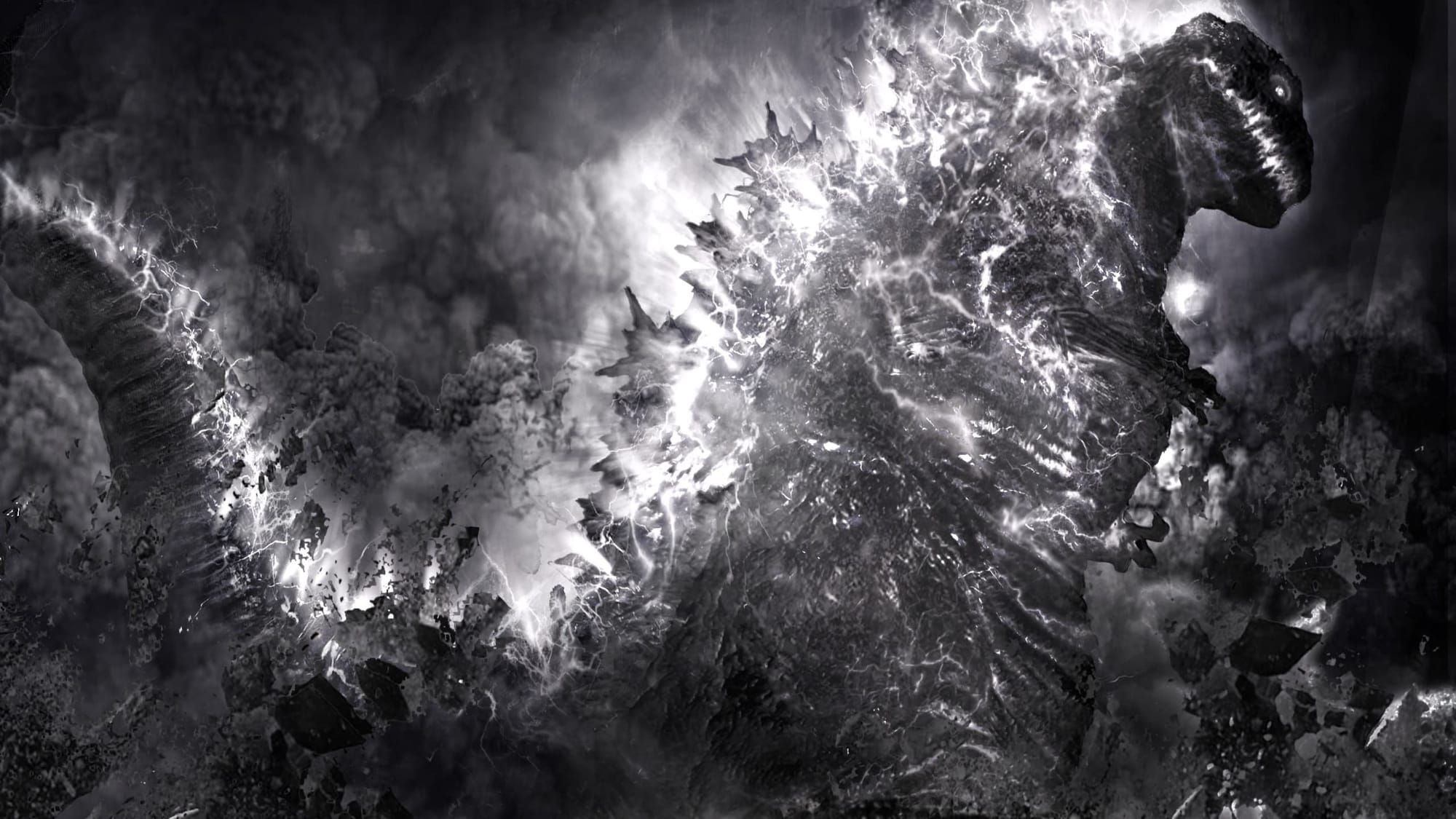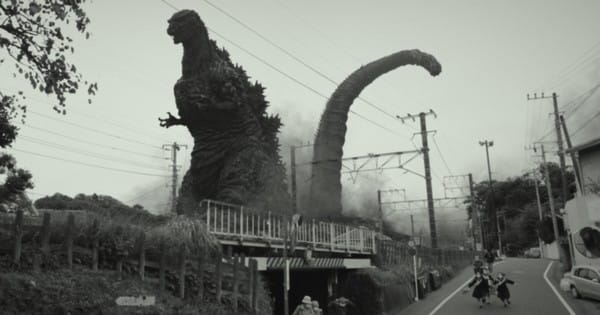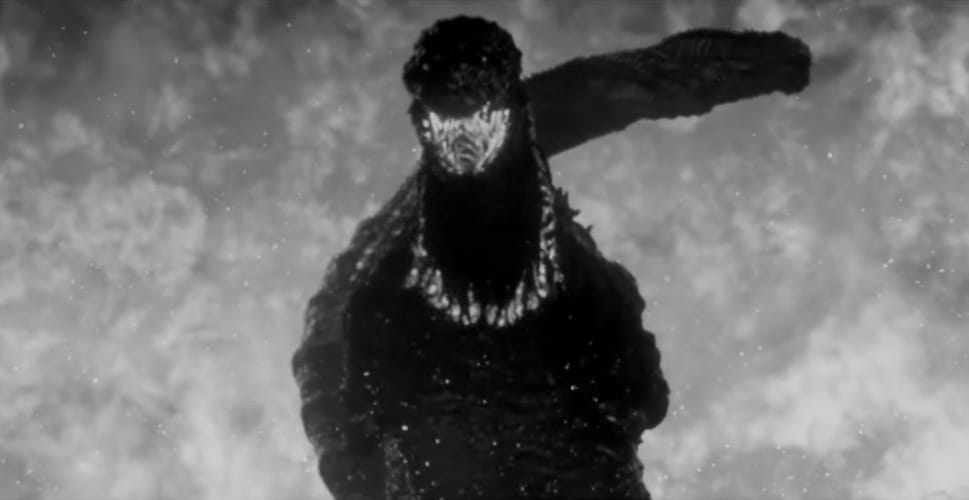Shin Godzilla: Orthochromatic (Anno Hideaki & Higuchi Shinji, 2016)

It’s hard to believe it’s been eight years since Shin Godzilla. I guess a lot of things have happened in the world since 2016, but it doesn’t really seem all that long ago. Anno Hideaki and Higuchi Shinji have since proceeded to reinvent the sci-fi films of their youth, building on their Godzilla with Shin Ultraman and Shin Kamen Rider. Anno’s reworking (yet again) of his epochal Evangelion series probably deserves to be considered in that group as well. Taken as a whole, their work over the last decade doubles as both a loving homage to and recreation of these iconic properties, with effects work that enhances the home-made feel of the originals rather than follow the path of digital verisimilitude that has led so many lesser filmmakers into the uncanny valley (or worse, a world of beige and gray where action scenes only happening at night or in drab murky sludge) in recent years. Now they’ve taken their attempt to mimic the style of the old movies one step further, and redone Shin Godzilla in black-and-white, dubbing it “Orthochromatic.”
I don’t know if they mean that literally. If I understand it correctly, orthochromatic film was an early version of black-and-white film that could only see a limited color spectrum. It was replaced by panchromatic film, which could take in the whole spectrum and thus give a more accurate grayscale image. I’m not sure if Anno and Higuchi are specifically looking for an orthochromatic look, or if they just like the word. It’s hard to tell from the screener I watched, which was a nice black-and-white that in some shots seemed tinged with green. But that could just as easily be a screener quality issue. Regardless, I’m certain the movie looks fantastic up on the big screen.

This is the second Godzilla movie to get the black-and-white treatment this year, following last fall’s monster (ahem) hit Godzilla Minus One. I’ve only seen the color version of that one, same with all the other recent movies that have released themselves in black-and-white (a trend that started with Fury Road, I think). I don’t really know that it has any specific purpose, beyond looking kind of neat. Maybe that’s enough—when I was a kid I used to turn the color all the way down on my TV to make everything look older too. I don’t know why I wanted to watch Night Court in black-and-white, but I did it anyway.
If nothing else, I guess it gives us a good excuse to watch Shin Godzilla again. I hadn’t seen it since it came out, and it may even be better now than it was then. All the goofy quirks that stood out the first time are still there: the zany camera placements; the deluge of on-screen text identifying every location, person (with their title, updated every time they get promoted), and piece of military equipment; the way Godzilla, the first time we see him, is wiggling like Shaq in that one GIF. The film’s satire of bureaucracy, its inability to cope with the unprecedented challenge before it during the initial Godzilla attack, plays a lot differently after we all lived through just such a disaster of governance during the COVID pandemic.

But this time, I get the sense that while the fact that every single command or decision has to be mediated through five or six different layers of leadership before any actions can be taken, the film doesn’t necessarily see that has a bad thing. Comical yes, but less bitingly than it felt the first time I saw it, after all, in the end, the system works (we don't see any actual people until the very end of the movie–the government are the real heroes here, full of smart and sexy people trying their absolute best to do the Right Thing). More than that, watching Shin Godzilla after seeing Godzilla Minus One, and the way a number of astute viewers criticized that film for sending a nationalistic message (a reading compounded by knowledge of director Yamazaki Takashi’s previous work, which apparently tends to whitewash the actions of the Japanese military during World War II—I haven’t seen it, so I can’t say for sure), I was surprised to see that Anno and Higuchi made just as nationalistic a movie.
The primary difference seems to be that Shin Godzilla is set in the present, while Godzilla Minus One begins in the final moments of the war and very much concerns itself with the hardships of its aftermath, particularly among discharged veterans. While I read these scenes through the lens of Japan’s post-war humanist cinema (Kurosawa, Mizoguchi, Naruse, Ozu), as attempting to show the effects of the war on the people who had to live through it (both at home and in serving), while taking no position on the specific causes of the war, other than to say that it was bad and a disaster for all involved, I can see how, given what I hear of Yamazaki’s earlier work, that can seem as an apologia for the psychotic nationalism that led Japan on its decades of conquest to begin with. But I don’t recall any such critique of Shin Godzilla, a movie which is very much about the need for the Japanese government to assert itself, both militarily, in allowing itself the freedom to use its military again, and internationally, by acting in its own interests rather than those of the United States or the rest of the international community (except France, which comes over to Japan’s side). "That country foists some crazy things on us.” was my takeaway line from Shin Godzilla the first time I saw it, an offhand remark about the often arcane and arduous, and in the course of the movie, near-apocalyptic once again, requirements the United States still imposes on Japan. This is including, hilariously, the name “Godzilla” itself, an English transliteration of the original Japanese “Gojira” which here comes before the Japanese name, which becomes instead a transliteration of the English word. In this movie, the real Godzilla was America all along.
